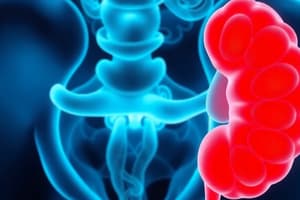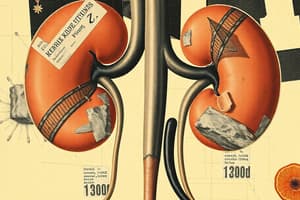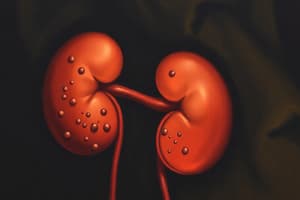Podcast
Questions and Answers
What is nephrolithiasis?
What is nephrolithiasis?
- The formation of stones in the kidney and urinary tract (correct)
- A type of urinary tract cancer
- A type of kidney disease
- A type of urinary tract infection
What is a risk factor for calcium-based stone formation?
What is a risk factor for calcium-based stone formation?
- Low-sodium diet
- Hypercalcemia (correct)
- Increased fluid intake
- High-potassium diet
What type of stones are associated with infection?
What type of stones are associated with infection?
- Calcium oxalate stones
- Uric acid stones
- Magnesium ammonium stones (correct)
- Brushite-containing stones
What is a disease associated with stone formation?
What is a disease associated with stone formation?
How are stones classified by location?
How are stones classified by location?
What is a risk factor for uric acid stone formation?
What is a risk factor for uric acid stone formation?
Which of the following diets can raise the calcium, uric acid, and oxalate levels in the urine and promote stone formation?
Which of the following diets can raise the calcium, uric acid, and oxalate levels in the urine and promote stone formation?
What is a common characteristic of patients with a high risk of developing urolithiasis?
What is a common characteristic of patients with a high risk of developing urolithiasis?
Which of the following is an indication for hospitalization in patients with nephrolithiasis?
Which of the following is an indication for hospitalization in patients with nephrolithiasis?
What is a differential diagnosis of nephrolithiasis?
What is a differential diagnosis of nephrolithiasis?
Which of the following is a type of calcium-based stone?
Which of the following is a type of calcium-based stone?
What is a risk factor for developing stones in the urinary tract?
What is a risk factor for developing stones in the urinary tract?
Which of the following diseases is associated with an increased risk of stone formation?
Which of the following diseases is associated with an increased risk of stone formation?
What is the size classification of stones up to 5 mm in largest diameter?
What is the size classification of stones up to 5 mm in largest diameter?
Flashcards are hidden until you start studying
Study Notes
Definition and Overview
- Nephrolithiasis is the formation of urinary calculi in the kidney that can deposit along the entire urogenital tract.
- Risk factors include low fluid intake, high-sodium, high-purine, and low-potassium diets.
- These diets can raise calcium, uric acid, and oxalate levels in urine, promoting stone formation.
Classification and Etiology
Calcium-Based Stones
- Risk factors: Hypercalcemia and low urinary output.
- Types: Calcium oxalate and calcium phosphate.
Magnesium Ammonium Stones
- Risk factors: Ammonium urate.
- Types: Ammonium urate.
Associated Factors
- Early onset of urolithiasis, especially in children and adolescents.
- Familial stone formation.
- Recurrent stone formers.
- Short time since the last episode.
- Brushite-containing stones.
- Uric acid and urate-containing stones.
- Infection stones.
Diseases Associated with Stone Formation
- Hyperparathyroidism.
- Metabolic syndrome.
- Nephrocalcinosis.
- Polycystic kidney disease (PKD).
- Gastrointestinal diseases (e.g., Crohn's disease, malabsorption).
- Increased levels of vitamin D.
- Sarcoidosis.
- Spinal cord injury, neurogenic bladder.
Classification by Location
- Upper, middle, or lower calyx.
- Renal pelvis.
- Upper, middle, or distal ureter.
- Urinary bladder.
Classification by Size
- Up to 5 mm in largest diameter.
- 5-10 mm in largest diameter.
- 10-20 mm in largest diameter.
- > 20 mm in largest diameter.
Nephrolithiasis Definition
- Nephrolithiasis is the formation of urinary calculi in the kidney, which can be deposited along the entire urogenital tract, from the renal pelvis to the urethra and bladder.
Risk Factors
- Low fluid intake is a risk factor for nephrolithiasis.
- High-sodium, high-purine, and low-potassium diets can raise calcium, uric acid, and oxalate levels in the urine, promoting stone formation.
Classification & Etiology
- Calcium-based stones (non-infectious stones) are associated with risk factors such as hypercalcemia and low urinary output.
- Types of calcium-based stones include calcium oxalate and calcium phosphate.
- Magnesium ammonium stones (infectious stones) are associated with risk factors such as ammonium urate.
- Types of magnesium ammonium stones include ammonium urate.
Associated Factors
- Early onset of urolithiasis, especially in children and adolescents, is an associated factor.
- Familial stone formation is an associated factor.
- Recurrent stone formers are at increased risk.
- Short time since the last episode is an associated factor.
- Brushite-containing stones, uric acid, and urate-containing stones are associated with nephrolithiasis.
- Infection stones are also an associated factor.
Diseases Associated with Stone Formation
- Hyperparathyroidism is a disease associated with stone formation.
- Metabolic syndrome is associated with stone formation.
- Nephrocalcinosis is a disease associated with stone formation.
- Polycystic kidney disease (PKD) is associated with stone formation.
- Gastrointestinal diseases, such as Crohn's disease and malabsorption, are associated with stone formation.
- Increased levels of vitamin D are associated with stone formation.
- Sarcoidosis is a disease associated with stone formation.
- Spinal cord injury and neurogenic bladder are associated with stone formation.
Classification of Stones
- Stones can be classified according to their anatomical position, including upper, middle, or lower calyx; renal pelvis; upper, middle, or distal ureter; and urinary bladder.
- Stones can be classified by size, including up to 5, 5-10, 10-20, and > 20 mm in largest diameter.
Indications for Hospitalization
- Significant renal stone in a solitary kidney is an indication for hospitalization.
- Severe kidney injury or an infected renal stone is an indication for hospitalization.
- Intractable pain or nausea, urinary extravasation, or hypercalcemic crisis are indications for hospitalization.
Differential Diagnosis
- Upper UTI's may be a differential diagnosis.
- Ectopic pregnancies may be a differential diagnosis.
- Ovarian torsion may be a differential diagnosis.
- Adnexal masses may be a differential diagnosis.
- Testicular torsion may be a differential diagnosis.
- Acute aortic syndromes may be a differential diagnosis.
- Renal artery aneurysms may be a differential diagnosis.
- Renal infarction, splenic infarction, bowel obstruction, diverticulitis, and appendicitis may be differential diagnoses.
Diagnostic Tools
- Ultrasound has a sensitivity of 45% and specificity of 94% for ureteral stones and a sensitivity of 45% and specificity of 88% for renal stones.
- Non-contrast CT-scan is the gold standard for diagnosis.
- Non-contrast CT-scan can detect uric acid and xanthine stones.
- Non-contrast CT-scan can determine stone density, inner structure of the stone, skin-to-stone distance, and surrounding anatomy.
- Non-contrast CT-scan can also diagnose other causes of abdominal pain.
- Non-contrast CT-scan has limitations, including loss of information on renal function and urinary collecting system anatomy.
Studying That Suits You
Use AI to generate personalized quizzes and flashcards to suit your learning preferences.




